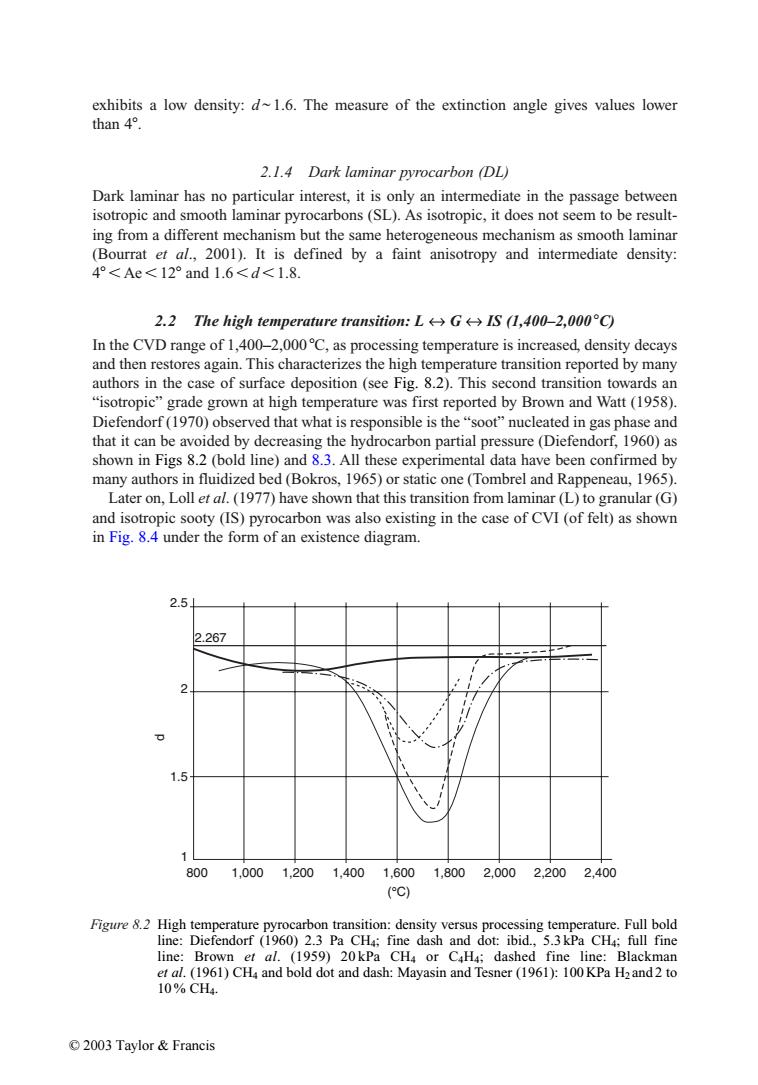正在加载图片...

exhibits a low density:d~1.6.The measure of the extinction angle gives values lower than4°. 2.1.4 Dark laminar pyrocarbon (DL) Dark laminar has no particular interest,it is only an intermediate in the passage between isotropic and smooth laminar pyrocarbons (SL).As isotropic,it does not seem to be result- ing from a different mechanism but the same heterogeneous mechanism as smooth laminar (Bourrat et al.,2001).It is defined by a faint anisotropy and intermediate density: 4°<Ae<12°and1.6<d<1.8. 2.2 The high temperature transition:L←)G←→IS(L,400-2,000CO In the CVD range of 1,400-2,000C,as processing temperature is increased,density decays and then restores again.This characterizes the high temperature transition reported by many authors in the case of surface deposition (see Fig.8.2).This second transition towards an "isotropic"grade grown at high temperature was first reported by Brown and Watt(1958). Diefendorf(1970)observed that what is responsible is the"soot"nucleated in gas phase and that it can be avoided by decreasing the hydrocarbon partial pressure(Diefendorf,1960)as shown in Figs 8.2 (bold line)and 8.3.All these experimental data have been confirmed by many authors in fluidized bed(Bokros,1965)or static one(Tombrel and Rappeneau,1965). Later on,Loll et al.(1977)have shown that this transition from laminar (L)to granular(G) and isotropic sooty(IS)pyrocarbon was also existing in the case of CVI(of felt)as shown in Fig.8.4 under the form of an existence diagram. 2.51 2.267 1.5 8001,0001,2001,4001,6001,8002,0002,2002,400 (C) Figure 8.2 High temperature pyrocarbon transition:density versus processing temperature.Full bold line:Diefendorf(1960)2.3 Pa CH4;fine dash and dot:ibid.,5.3 kPa CH4;full fine line:Brown et al.(1959)20kPa CH4 or C4H4;dashed fine line:Blackman et al.(1961)CHa and bold dot and dash:Mayasin and Tesner (1961):100 KPa H2and2 to 10%CH4 ©2003 Taylor&Francisexhibits a low density: d ~ 1.6. The measure of the extinction angle gives values lower than 4. 2.1.4 Dark laminar pyrocarbon (DL) Dark laminar has no particular interest, it is only an intermediate in the passage between isotropic and smooth laminar pyrocarbons (SL). As isotropic, it does not seem to be resulting from a different mechanism but the same heterogeneous mechanism as smooth laminar (Bourrat et al., 2001). It is defined by a faint anisotropy and intermediate density: 4 Ae 12 and 1.6 d 1.8. 2.2 The high temperature transition: L ↔ G ↔ IS (1,400–2,000 C) In the CVD range of 1,400–2,000 C, as processing temperature is increased, density decays and then restores again. This characterizes the high temperature transition reported by many authors in the case of surface deposition (see Fig. 8.2). This second transition towards an “isotropic” grade grown at high temperature was first reported by Brown and Watt (1958). Diefendorf (1970) observed that what is responsible is the “soot” nucleated in gas phase and that it can be avoided by decreasing the hydrocarbon partial pressure (Diefendorf, 1960) as shown in Figs 8.2 (bold line) and 8.3. All these experimental data have been confirmed by many authors in fluidized bed (Bokros, 1965) or static one (Tombrel and Rappeneau, 1965). Later on, Loll et al. (1977) have shown that this transition from laminar (L) to granular (G) and isotropic sooty (IS) pyrocarbon was also existing in the case of CVI (of felt) as shown in Fig. 8.4 under the form of an existence diagram. Figure 8.2 High temperature pyrocarbon transition: density versus processing temperature. Full bold line: Diefendorf (1960) 2.3 Pa CH4; fine dash and dot: ibid., 5.3 kPa CH4; full fine line: Brown et al. (1959) 20 kPa CH4 or C4H4; dashed fine line: Blackman et al. (1961) CH4 and bold dot and dash: Mayasin and Tesner (1961): 100 KPa H2 and 2 to 10 % CH4. 2.5 2.267 d 2 1.5 1 800 1,000 1,200 1,400 1,600 (°C) 1,800 2,000 2,200 2,400 © 2003 Taylor & Francis